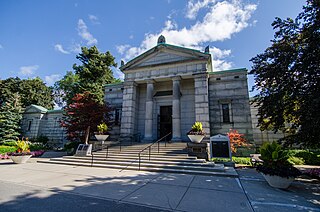
Mount Pleasant Cemetery is a cemetery located in Toronto, Ontario, Canada, and is part of the Mount Pleasant Group of Cemeteries. It was opened in November 1876 and is located north of Moore Park, a neighbourhood of Toronto. The cemetery has kilometres of drives and walking paths interspersed with fountains, statues and botanical gardens, as well as rare and distinct trees. It was originally laid out by German-born landscape architect Henry Adolph Engelhardt, inspired by the European and American garden cemeteries of the 19th century, and with influences from Mount Auburn Cemetery in Boston.
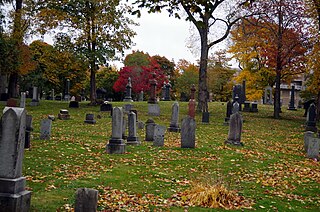
Fairview Cemetery is a cemetery in Halifax, Nova Scotia, Canada. It is perhaps best known as the final resting place for over one hundred victims of the sinking of the Titanic. Officially known as Fairview Lawn Cemetery, the non-denominational cemetery is run by the Parks Department of the Halifax Regional Municipality.

Prescott is a town on the north shore of the Saint Lawrence River in province of Ontario, Canada. The town is a part of the United Counties of Leeds and Grenville. In 2021, it had a population of 4,078. The Ogdensburg–Prescott International Bridge, 5 kilometres (3.1 mi) east of Prescott at Johnstown, crosses the Canada–United States border and connects the town with the city of Ogdensburg, New York.

Deer Park is a neighbourhood in Toronto, Ontario, Canada. It is centered on the intersection of Yonge Street and St. Clair Avenue and its boundaries are the Vale of Avoca section of Rosedale ravine in the east, Farnham Avenue and Jackes Avenue in the south, Avenue Road and Oriole Parkway in the west, the Beltline Trail in the north on the west side of Yonge Street, and Glen Elm Avenue in the north on the east side of Yonge Street. For the purposes of social policy analysis and research, the Toronto government’s Social Development & Administration division includes Deer Park within the City of Toronto's official "Rosedale-Moore Park" and "Yonge-St.Clair" neighbourhood profiles. The neighbourhood is in Ward 22, represented by Councillor Josh Matlow at Toronto City Council.

The R. C. Harris Water Treatment Plant in Toronto, Ontario, Canada, is both a crucial piece of infrastructure and an architecturally acclaimed historic building named after the longtime commissioner of Toronto's public works Roland Caldwell Harris. The plant's architect was Thomas C. Pomphrey with engineers H.G. Acres and William Gore. It is located in the east of the city at the eastern end of Queen Street and at the foot of Victoria Park Avenue along the shore of Lake Ontario in the Beaches neighbourhood in the former city of Scarborough.
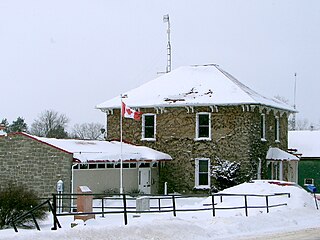
Elizabethtown-Kitley is a township in eastern Ontario, Canada, in the United Counties of Leeds and Grenville. Its southern border lies along the St. Lawrence River and it extends north into many rural hamlets and villages. The township was created on January 1, 2001, by the amalgamation of the former Township of Elizabethtown and Township of Kitley.

Toronto—St. Paul's is a federal electoral district in Toronto, Ontario, Canada, that has been represented in the House of Commons of Canada since 1935. Before the 2015 election, the riding was known as St. Paul's.

The Cathedral Church of St. James is an Anglican cathedral in Downtown Toronto, Ontario, Canada. It is the location of the oldest congregation in the city, with the parish being established in 1797. The church, with construction beginning in 1850 and opening for services on June 19, 1853, was one of the largest buildings in the city at that time. It was designed by Frederick William Cumberland and is a prime example of Gothic Revival architecture.

St. Paul's Church is an evangelical Anglican church in downtown Halifax, Nova Scotia, within the Diocese of Nova Scotia and Prince Edward Island of the Anglican Church of Canada. It is located at the south end of the Grand Parade, an open square in downtown Halifax with Halifax City Hall at the northern end.

The Upper Beaches is a neighbourhood in Toronto, Ontario, Canada. It is directly north of the Beaches area. It stretches from Coxwell Avenue in the west to Victoria Park in the east. The southern border is Kingston Road, while the northern boundary is generally considered to be the Canadian National Railway tracks between Gerrard Street and Danforth Avenue. The western part of the area was originally called Norway, and the larger area was once part of the Town of East Toronto. The name "Upper Beaches" was first used by developers and real estate agents around the period of 2001 to 2003 for the selling of houses on redeveloped land in the area, and was used as a marketing tag to attract buyers. The area was never considered part of the Beaches neighbourhood but was close to it. The city's current name for this area is East End Danforth, though that is rarely used. The city also includes the buildings along and just north of Danforth Avenue in the neighbourhood. The western portion between Woodbine Avenue and Coxwell is referred to by the city as Woodbine Corridor.
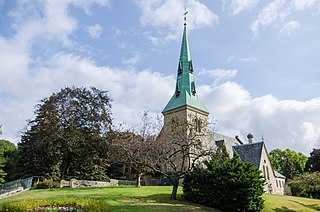
St. James' Cemetery is a historic cemetery in Toronto, Ontario, Canada. It is the oldest cemetery in Toronto that is still in use, having opened in 1844. It was originally the burial ground for the Cathedral Church of St. James, but it later became non-denominational. The main entrance to the cemetery is located at 635 Parliament Street, north of Wellesley Street East. Just to the west is the St. James Town neighbourhood, which is named after the cemetery.

The City of London Cemetery and Crematorium is a cemetery and crematorium in the east of London. It is owned and operated by the City of London Corporation. It is designated Grade I on the Historic England National Register of Historic Parks and Gardens.
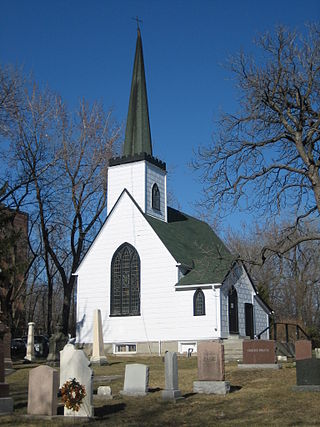
The Church of St. Jude is an historic church in the Scarborough area of Toronto, Ontario, Canada. St. Jude's was originally built in what was the small rural village of Wexford, Ontario in 1848. The original church building survives today, being used as the cemetery chapel, making it one of the oldest surviving churches in Scarborough. The land for the church was donated to Bishop John Strachan and the Anglican Diocese of Toronto by Patrick and Ann Parkin. They had used this corner of their farm as a family cemetery. The church was built atop a small hill, so that it dominated the surrounding landscape. The still operational cemetery surrounds the church, and has graves dating back to 1832. Local farmers built the church with lumber milled from nearby trees. The Gothic revival structure was designed by Reverend William Darling, the Anglican minister for Scarborough township. It is a replica in miniature of a church he remembered from his native Scotland. Keeping the proportions of the original while greatly shrinking the structure explains why the sacristy entrance is only five feet high. Darling's son, Frank Darling, would later become a prominent Toronto architect himself.
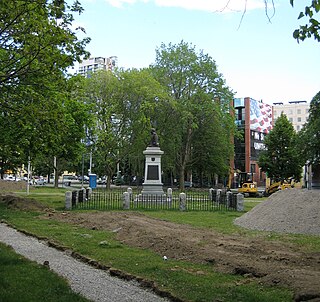
Victoria Memorial Square is a park and former cemetery in Toronto, Ontario, Canada. Established in 1793 as the burial place for those affiliated with the nearby Toronto Garrison. It was the first cemetery to be used by European settlers in what would become the city of Toronto. Originally known as St. John's Square, the park today is part of Fort York National Historic Site, and the site of a monument to the War of 1812 sculpted by Walter Seymour Allward and completed in 1902.

Reading Old Cemetery is situated in the eastern part of Reading, Berkshire, England. It is located immediately to the east of Cemetery Junction, a major road junction in Reading. The cemetery is Grade II listed.

The English coastal city of Brighton and Hove, made up of the formerly separate Boroughs of Brighton and Hove in East Sussex, has a wide range of cemeteries throughout its urban area. Many were established in the mid-19th century, a time in which the Victorian "cult of death" encouraged extravagant, expensive memorials set in carefully cultivated landscapes which were even recommended as tourist attractions. Some of the largest, such as the Extra Mural Cemetery and the Brighton and Preston Cemetery, were set in particularly impressive natural landscapes. Brighton and Hove City Council, the local authority responsible for public services in the city, manages seven cemeteries, one of which also has the city's main crematorium. An eighth cemetery and a second crematorium are owned by a private company. Many cemeteries are full and no longer accept new burials. The council maintains administrative offices and a mortuary at the Woodvale Cemetery, and employs a coroner and support staff.

St. James on-the-Lines is a historic Anglican garrison church in Penetanguishene, Ontario. The church is still in use today serving as the Anglican parish church in Penetanguishene for services from Easter to Thanksgiving. The church is protected by a heritage conservation easement under the Ontario Heritage Act. There are two suggested origins for its full name. The first suggestion comes from its location on the lines of communication or road from the former military establishment at Penetanguishene to the south. The second possible meaning is from the old Victorian military usage of Lines for the rows of tents or buildings in a military camp. The church was constructed close to the original military establishment buildings which lined the road.
The following outline is provided as an overview of and topical guide to Toronto:

The St. John's Indian Residential School, also known as the Chapleau Indian Residential School, was a Canadian Indian Residential School operated by the Anglican Church of Canada from 1907 to 1948 in Chapleau, Ontario.



















